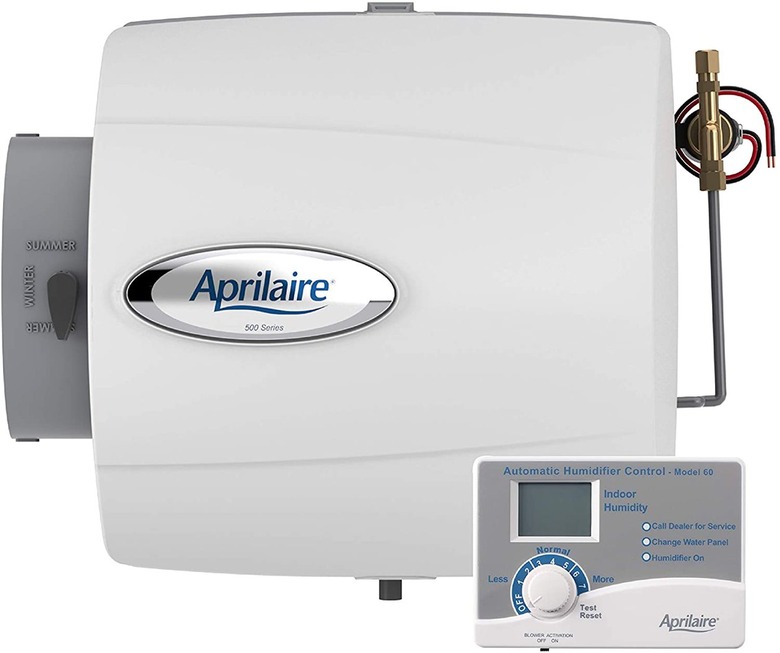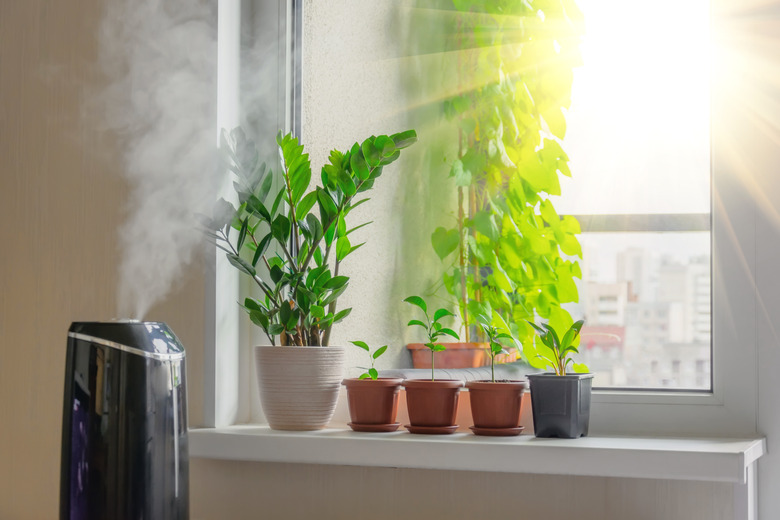Does Your Home Need A Whole-House Humidifier?
We may receive a commission on purchases made from links.
Winter is the season in which humidity levels in most homes are the lowest, and it's when whole-house humidifiers make the most sense. Running in conjunction with a home's HVAC system and connected to the same ductwork, a whole-house humidifier can dump several gallons of water into the air, raising the indoor humidity and actually making the home feel warmer in the process. In the summer, whole-house humidifiers are also useful because they counteract the dehydrating effects of air conditioning systems, and in arid regions with extremely low outdoor humidity, that can make a huge difference in the comfort level.
The decision to humidify the air circulating through the central air ductwork isn't a slam dunk, however, because elevated humidity levels introduce new problems, the main one being a negative impact on indoor air quality. Where there is moisture, there is usually mold, and circulating moldy air through the house can severely affect people with allergies and even make them sick. Although the cost of installing whole-house humidifiers isn't prohibitive (typically between $300 and $1,100), it's money poorly spent if you discover that you have to leave your humidifier off for health reasons.
Homeowners create humidity naturally in their homes by going about daily activities, such as cooking food, taking showers and drying clothes, and modifying those behaviors may raise the home's humidity enough to alleviate the dryness. For example, leaving the bathroom door open while showering allows steam to dissipate throughout the house. If something like that doesn't work or isn't an option, a portable humidifier may be all that's needed for a good night's sleep. However, when dry air creates serious problems, like persistent dry skin or gapping wood floors, it may take the power of a whole-house humidifier to alleviate them.
Tip
A whole-house humidifier can make you more comfortable — especially in the winter months — but some types of humidifiers are prone to mold, which can circulate along with the humidified air. A steam humidifier is the least prone to this type of problem.
Types of Whole-House Humidifiers
Types of Whole-House Humidifiers
If you opt for a whole-house humidifier, you can choose a bypass humidifier, a fan-powered one or one that generates steam by means of an electric heating element. Many HVAC professionals agree that the best whole-house humidifiers are the ones that generate steam. They raise humidity faster than the other types and are less likely to affect air quality, but because they consume electricity, they are likely to have a non-negligible impact on your energy bill. Steam generators are especially recommended for homes with heat pumps because a heat pump system operates at a lower temperature than a furnace and benefits from the extra heat provided by the steam.
A bypass humidifier is the simplest option and has the least impact on energy costs. It's typically mounted on the air handler plenum and relies on the existing HVAC blower to circulate air through a water tray and return the humidified air to the supply ducts. Installation requires additional ductwork, but once it's in place, a bypass humidifier requires no extra energy to operate. It won't work if the blower isn't on, though, so in the long run, it could drive up energy costs since you have to turn on the furnace to use it even if the house is already warm enough.
Like bypass humidifiers, fan-powered whole-house humidifiers also mount on the cold air return or warm air supply sides of the air handler plenum, but they have electric fans that switch on independently of the furnace. The two types are flow-through — which have evaporator pads and work almost exactly like swamp coolers — and drum-style, which feature a slowly rotating drum with a sponge that picks up water from a tray and passes it through the airflow from the fan. Both types are able to add humidity faster than a bypass humidifier and will come on whenever the humidistat calls for moisture, regardless of whether or not the thermostat calls for heat. Drum humidifiers can also be installed in a bypass format.
What's Involved With Installation?
What's Involved With Installation?
Although it isn't generally a DIY project, installation of whole-house humidifiers is not difficult or expensive. Units typically cost between $150 and $300, although steam and cool-mist humidifiers, which also spray water vapor into the air stream, are more expensive, costing as much as $1,000, and installation also costs more. Labor can be anywhere from $65 to $125 per hour depending on location and the installer you choose, and the amount of time the job takes depends on your HVAC configuration and the type of humidifier you choose.
The installation process for a fan-powered unit typically follows this sequence:
- After turning off the furnace or heat pump, you cut a hole for the humidifier in the return or warm air supply stack. A template is usually provided. You then install the mounting plates.
- You cut another hole for the humidistat in the cold air plenum, install the humidistat and connect it to the furnace controls. Following the manufacturer's instructions, you then connect the humidistat to the humidifier.
- The humidifier needs a water supply pipe. You generally connect this to one of the home's hot water supply pipes with a tee or, if allowed by local codes, a saddle valve.
- Bypass and flow-through humidifiers need a drain hose. If you're using the humidifier alongside a high-efficiency condensing furnace, this can tie into the condensate drain line. Otherwise, you have to run a separate tube to a suitable runoff location.
Bypass humidifiers call for extra ducting to provide intake air for the humidifier and allow the device to exhaust moist air into the warm air supply duct. The ductwork takes up space, making a bypass humidifier unsuitable for systems in confined spaces, such as a closet. A steam or cool mist humidifier is typically mounted next to the furnace near the air supply duct and is connected to water and electricity, and only a small hole is required in the duct through which to pass the dispersion tube, making it flexible enough to allow these units to be installed in small spaces.
Will Whole-House Humidification Serve You?
Will Whole-House Humidification Serve You?
If the relative humidity in your house is habitually below 20 percent, you probably feel uncomfortable, and you may be experiencing skin problems and other ailments associated with dry air, but it isn't just you that's suffering. Wood contracts when it gets dehydrated, and you're probably noticing signs of this, including warped wooden furniture, cracks, gaps and curling in your wood floors. You may also notice musical instruments going out of tune. Low humidity can even cause paint to flake off the walls. It makes sense to install a humidifier to alleviate these problems, but it might not work if your house isn't properly sealed.
If your walls and floor have air gaps, there's a constant exchange of air between the inside of your house and the outside in the winter when the furnace is running. The outside air is also dry, so the net change in indoor humidity may not be great enough to make a difference in comfort level. You can rectify this by sealing all the gaps and cracks through which air infiltration can occur, but in some older homes, this may be next to impossible to accomplish.
In the summer months, you may run an air conditioner to stay cool, but an air conditioner is basically a dehumidifier. Moisture in the air condenses around the evaporator coils, falls into a drain pan and gets drained out of the building. A humidifier may not supply enough moisture to counteract this effect — especially in a house that isn't properly sealed and is exchanging air with the outside air. Besides, in summer, the outside air may already be humid unless you live in an arid climate. In this case, a swamp cooler, which is essentially an evaporative humidifier, would be a more efficient way to cool the house.
Whole-House Humidifiers and Air Quality
Whole-House Humidifiers and Air Quality
Steam humidifiers have the least impact on air quality, but even they can be problematic in this regard. As the steam circulates in the ducts, some of it is bound to cool and condense on the duct walls, and that's a recipe for mold. Any mold that gets established taints the air, and if it triggers allergic reactions, the ducts may have to be cleaned and sanitized. This is less likely to happen if your ducts are made of fiberglass duct board rather than galvanized steel.
Despite this possibility, professionals generally agree that steam humidifiers are the least likely of any to cause mold problems. Other types of humidifiers have a water reservoir and a medium though which water and air have to combine. These are playgrounds for pathogens, and if they aren't kept meticulously clean, the pathogens, including mold and bacteria, circulate throughout the house with the humid air. Even if people in the house don't experience respiratory problems, the pathogens can cling to walls, floors and other surfaces and grow into colonies unless you clean and sanitize regularly.
Alternatives to Whole-House Humidifiers
Alternatives to Whole-House Humidifiers
A house that's tight enough to benefit from whole-house humidification likely has some type of active ventilation system to exchange stale indoor air with fresh outside air. The most common type of air exchanger, a heat recovery ventilator (HRV), is able to recover heat from the indoor air and recirculate it. If you have one of these, consider replacing it with an energy recovery ventilator (ERV), which recovers both heat and humidity. An ERV doesn't add humidity to your home's air, but it prevents much of the humidity from being lost outside, and that may be enough to keep the indoor relative humidity at a comfortable level without the danger of mold.
You might also consider deploying one or more portable humidifiers in the parts of the home that suffer the most from lack of humidity. These units are ductless and don't require installation, although you do have to empty and clean them regularly to keep mold under control. Their operation is similar to that of a flow-through humidifier in that they blow air through a porous membrane moistened by a steady stream of water. One of these humidifiers can prevent you from developing a scratchy throat while you're sleeping or can protect the wood floors in a medium-sized room from warping and separating.
A third option is to increase daily activities that create humidity, such as cooking, showering, washing clothes and keeping doors open so the humidity can spread throughout the house. Some ways to create humidity through daily activities include:
- Place bowls of water on heat registers and sunny windowsills so the water can slowly evaporate.
- Leave water in the bathtub after you're done bathing and let it cool down. Open the bathroom door to let the water vapor circulate through the house.
- Get some houseplants. The more you have and the greener they are, the better. Plants transpire the water you give them through their leaves. Choose plants with lush greenery; they will also improve indoor air quality and the scenery.
- Open your dishwasher as soon as it stops and let the steam waft through the kitchen.
References
- HomeServe: Does Your Home Need a Whole-House Humidifier?
- PV Heating & Air: Do You Really Need That Whole-House Humidifier?
- HVAC.com: Different Types of Whole-House (Central) Humidifiers
- Inch Calculator: Cost to Install Whole House Humidifier – 2021 Price Guide
- Simplemost: 11 DIY Ways To Increase The Humidity In Your Home (Without Purchasing A Humidifier)


